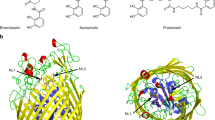Abstract
Free iron availability is strongly limited in vertebrate hosts, making the iron acquisition by siderophores inappropriate. Pathogenic bacteria have developed various ways to use the host's iron from iron-containing proteins. Serratia marcescens can use the iron from hemoglobin through the secretion of a hemophore called HasA, which takes up the heme from hemoglobin and shuttles it to the receptor HasR, which in turn, releases heme into the bacterium. We report here the first crystal structure of such a hemophore, bound to a heme group at two different pH values and at a resolution of 1.9 Å. The structure reveals a new original fold and suggests a hypothetical mechanism for both heme uptake and release.
This is a preview of subscription content, access via your institution
Access options
Subscribe to this journal
Receive 12 print issues and online access
$189.00 per year
only $15.75 per issue
Buy this article
- Purchase on Springer Link
- Instant access to full article PDF
Prices may be subject to local taxes which are calculated during checkout




Similar content being viewed by others
References
Neiland, J.B. Annu. Rev. Biochem. 50, 715–731 (1981).
Postle, K. J. Bioenerg. Biomembr. 25, 591–601 (1993).
Ferguson, A.D., Hofmann, E., Coulton, J.W., Diederichs, K. & Welte, W. Science 282, 2215–20 (1998).
Buchanan, S.K. et al. Nature Struct. Biology 6, 56–63 (1999).
Gray-Owen, S.D. & Shryvers, A.B. Trends Microbiol. 4, 185–191 (1996).
Lee, B.C. Mol. Microbiol. 18, 383–390 (1995).
Hanson, M.S., Pelzel, S.E., Latimer, J.L., Muller-Eberhard, U. & Hansen, E.J. Proc. Nat. Acad. Sci. USA 89, 1973–1977 (1992).
Létoffé, S., Ghigo, J.M. & Wandersman, C. Proc. Natl. Acad. Sci. USA 91, 9876–9880 (1994).
Wolff, N., Delepelaire, P., Ghigo, J.M. & Delepierre, M. Eur. J. Biochem. 234, 400–407 (1997).
Ghigo, J.M., Létoffé, S. & Wandersman, C. J. Bacteriol. 179, 3572–3579 (1997).
Létoffé, S. Redeker, V. & Wandersman, C. Mol. Microbiol. 28, 1223–1234 (1998).
Izadi, N., Henry, Y., Haladjian, J., Goldberg, M.E., Wandersman, C., Delepierre, M. & Lecroisey, A. Biochemistry 36, 7050–7057 (1997).
Chan, A.W.E., Hutchinson, E.G., Harris, D. & Thornton, J.M. Protein Sci. 2, 1574–1590 (1993).
Orengo, C.A. & Thornton, J.M. Structure 1, 105–120 (1993).
Reid, D.J., Murthy, M.R., Sicignano, A., Tanaka, N., Musik, W.D. & Rossman, M.G. Proc. Natl. Acad. Sci. USA 78, 4767–4771 (1981).
Williams, P.A., Fülöp, V., Garman, E.F., Saunders, N.F.W., Ferguson, S.J. & Hajdu, J. Nature 389, 406–412 (1997).
Maurus, R. et al. J. Biol. Chem. 269, 12606–12610 (1994).
Tsai, A., Kulmacz, R.J., Wang, J., Wang, Y., Van Wart, H.E. & Palmer, G. J. Biol. Chem. 268, 8554–8563 (1993).
Cheesman, M.R., Ferguson, F.J., Moir, J.W.B., Richardson, D.J., Zumft, W.G. & Thomson, A.J. Biochemistry 36, 16267–16276 (1997).
Rees, D.C. Proc. Natl. Acad. Sci. USA 82, 3082–3085 (1985).
Stellwagen., E. Nature 275, 73–74 (1978).
Czjzek, M., Payan, F. & Haser R. Biochimie 76, 546–553 (1994).
Létoffé, S., Ghigo, J.M. & Wandersman, C. J. Bacteriol. 176, 5372–5377 (1994).
Ottwinovski, Z. DENZO: An oscillation data processing program for macromolecular protein. (Yale University, New Haven, Connecticut;1993).
Collaborative Computational Project No 4. Acta Crystallogr. D 50, 760–763 (1994).
De La Fortelle, E. & Bricogne, G. Macromolecular crystallography. Methods Enzymol. 276, 472–494 (1997).
Roussel, A. & Cambillau, C. In Silicon graphics geometry partners directory, pp. 86, (Silicon Graphics, Mountain View, California 1991).
Brünger, A.T. X-PLOR: a system for X-Ray Crystallography and NMR. (Yale University Press, New Haven, Connecticut; 1996).
Brünger, A.T. Nature 355, 472–475 (1992).
Laskovski, R.A., MacArthur, M.W., Moss, D.S. & Thornton, J.M. J. Appl. Crystallogr. 26, 283–291 (1993).
Holm, L. & Sander, C. J. Mol. Biol. 233, 123–138 (1993).
Kraulis, P.J. J. Appl. Crystallogr. 24, 946–950 (1991).
Nicholls, A., Sharp, K.A. & Honig, B. Proteins 11, 281–296 (1991).
Meritt, E.A. & Murphy, M.E.P. Acta Crystallogr. D 50, 869–873 (1994).
Acknowledgements
This work was supported by the Centre National de la Recherche Scientifique through the program Physique et Chimie du Vivant. We thank K. Brown and Y. Bourne for carefully reading the manuscript.
Author information
Authors and Affiliations
Corresponding author
Rights and permissions
About this article
Cite this article
Arnoux, P., Haser, R., Izadi, N. et al. The crystal structure of HasA, a hemophore secreted by Serratia marcescens. Nat Struct Mol Biol 6, 516–520 (1999). https://doi.org/10.1038/9281
Received:
Accepted:
Issue Date:
DOI: https://doi.org/10.1038/9281
This article is cited by
-
Binding of HasA by its transmembrane receptor HasR follows a conformational funnel mechanism
European Biophysics Journal (2020)
-
Structural properties of a haemophore facilitate targeted elimination of the pathogen Porphyromonas gingivalis
Nature Communications (2018)
-
Structural basis of haem-iron acquisition by fungal pathogens
Nature Microbiology (2016)
-
Corynebacterium diphtheriae HmuT: dissecting the roles of conserved residues in heme pocket stabilization
JBIC Journal of Biological Inorganic Chemistry (2016)
-
Differential roles of tryptophan residues in conformational stability of Porphyromonas gingivalis HmuY hemophore
BMC Biochemistry (2014)



